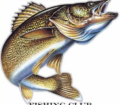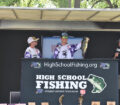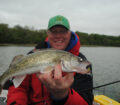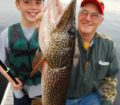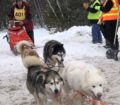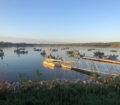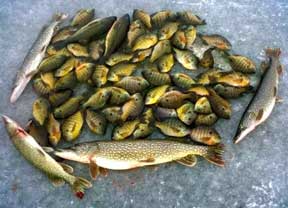
(photo by Kevan Paul) The results of targeting both bluegills and northern pike on the same fishing trip.
By Steve Weisman
The Iowa Great Lakes is an ice fishing destination for both Iowa anglers and out-of-staters. After all, there is great walleye fishing and panfishing (perch, bluegill and crappie). If an angler is interested, there are also shallows teeming with largemouth bass that will readily attack smaller panfish lures. However, there is one species that is most often overlooked: northern pike.
Mike Hawkins, Iowa DNR Biologist at the Spirit Lake Hatchery, agrees saying, “Both Big Spirit Lake and West Okoboji have excellent pike populations. It is really an untapped resource.” The good news is this. If you like fishing panfish in the weedy bays of Big Spirit and West Okoboji, you are also in pike waters. After all, weeds + panfish = pike in the vicinity. The process is really pretty simple. Find the weeds, find the panfish…the pike will be cruising the area.
First of all, it’s about location. Not all weeds will contain fish, and there are a lot of weedbeds in these lakes. However, areas to choose on Big Spirit include Anglers Bay and Hales Slough, while top bays on West Okoboji include Big and Little Emerson Bay, Little Millers and Millers Bay, North Bay, Smiths Bay and Haywards Bay. Now that’s a lot of territory to cover, but you can actually cut this down by season. Anglers Bay and Little Millers and Little Emerson are the first areas that freeze over. So, those are the areas you target first. Then as the winter progresses, you can hit the other bays if things have slowed down.
This really becomes the best of two fishing worlds, because you can fish panfish and northern pike at the same time. The water on West Okoboji is most often gin clear, so you will get to see everything that comes through below the ice.
I remember a friend of mine visited me from Kentucky and since he had never been ice fishing, he wanted to give it a try. His first comment as we drove on to the ice on Millers Bay was “This is cool.” It was later followed by “Oh my” when the ice cracked right beneath my shack and water moved in the hole. However, the best was when I heard him exclaim, “Will you look at that!” Soon the head of a big pike was under my hole, while the tail was just entering his hole! “Holy cow!”
Needless to say, the panfish are an indicator. If they suddenly disappear and don’t come back, you can bet a pike is sitting off to the side! Mobility is a key for success for both panfish and pike. The first few times out, it might take digging lots of holes and moving around until you find the pattern. It seems that once you find the fish (and if there is little to no angler activity around you), they will stick around for a while. Sometimes, the fish will move 20 yards away to the end of the weedbed or maybe a little deeper. If nothing is happening, I will check those close spots out before I move to another weedbed or even another bay.
Game Plan
Early in the season, you might set up as shallow as 3-4 feet or up to 10-12 feet of water. It all depends on the weeds and where the panfish are located. Plus, if the ice froze crystal clear, you might have to move out to deeper weedbeds so as not to spook the fish. To speed up the process, after drilling several holes, I will use my underwater camera (Vexilar Scout) to search for both bluegills and pike. The key, obviously, is to set up where the fish are! Most anglers will use one rod to work panfish, and then put a tip-up out for a pike. However, if you pay the fee for a third line, you can double up and add a second tip-up. Size varies, but in the shallower waters, but they usually run anywhere from 2-5 pounds.
The rig
A friend of mine, guide Kevan Paul, owner of Kevan Paul’s Guide Service (www.paulsfishingguide.com) and a Clam pro staffer, spends a lot of the winter putting clients on both panfish and northern pike. Here is his strategy. Typically, Paul sets out a series of tip-ups trying to pick areas where pike will be cruising around searching for an easy meal throughout the day. He will spool the reel with 20-pound braid and then use a Bigtooth Rig made by Clam Outdoors with a chub for bait. “With the clear water, I like the gold blades the best, but I also will use red. If it is shallow water, shallower than 10 feet, I will not use a leader, but in deeper water I will use a 3-foot Flurocarbon leader (20 pound test).”
Paul takes the chub and takes one treble hook and gets one of the hooks secured just under the skin just behind the dorsal fin on one side. He does the same thing with the other treble hook on the side. To help attract the pike, Paul will clip the tail off where the tail meets the body of the chub. “This gives a ‘blood’ scent trail, and if a pike is in the area, it’ll come to the chub.” It’s not necessary to get the bait on the bottom because pike often cruise up off the bottom.
Handling the strike
The Bigtooth Rig is a quick strike rig, so Paul stresses not to wait a long time to set the hook. “When the flag trips, get over there and lift the tip-up out of the water. Let the pike take the line so they don’t feel resistance. At the same time, strip off some extra line just in case the pike makes a big run. Set the hook when the fish is making a run and work the fish toward the hole. If we are keeping pike, I will have a gaff handy in case, but if not, we’ll get it coming up the hole and then grab it under the gill. Just make certain to be careful. I suggest having a glove to protect your hand.”
Paul does one more thing to heighten the northern pike experience for his clients. “I will have a tip-up ready with an already hooked lively chub in a bucket of water. When we see a pike enter our fishing area, we’ll take the chub and put it down the hole. This will often trigger a response from the pike. What a rush when you see it take the bait!”
As the season goes
Things will change as the ice season goes. “By mid-season, I often find the bigger pike moving into deeper water, say a rock pile or a deep weedline up to 20-feet or so. It’s here that we get the chance to catch pike over 10 pounds.”
At late ice, things change again. Pike are getting ready to spawn, often times spawning beneath the ice. In preparation, they will move to areas where water is flowing into the lake.
Taking a chance
Want a challenge? Sometimes it works; sometimes it doesn’t. It’s happened to me many times. As I work my panfish rig, say a Clam Dingle Drop tipped with silver wigglers or wax worms, I often have northern pike come into view. If I really work them, they will slowly move toward the bait, sizing it up. Many a time I have pulled the bait away just as the pike opens its mouth to inhale the jig. I then drop the jig on its head to see if it will leave the vicinity. However, if I am in a daring mood, I will let the pike suck in the jig and carefully lift the hook until the line is taut, trying to see if I can move the pike toward the hole without making it take off in a screaming run! If they haven’t figured out that they are really hooked and I can get the head toward the hole, I’ve got a chance. If they do run and the line doesn’t get across their teeth, I will back reel and go with them. Luck, obviously, has to be with me! Northern pike up to 5-6 pounds have come up the hole this way. Yes, I do get broken off, but wow is it a rush when it works out!
No doubt about it! The northern pike are plentiful on both Big Spirit and West Okoboji. They are great fighters, and they also make great table fare. That is a perfect combination!

